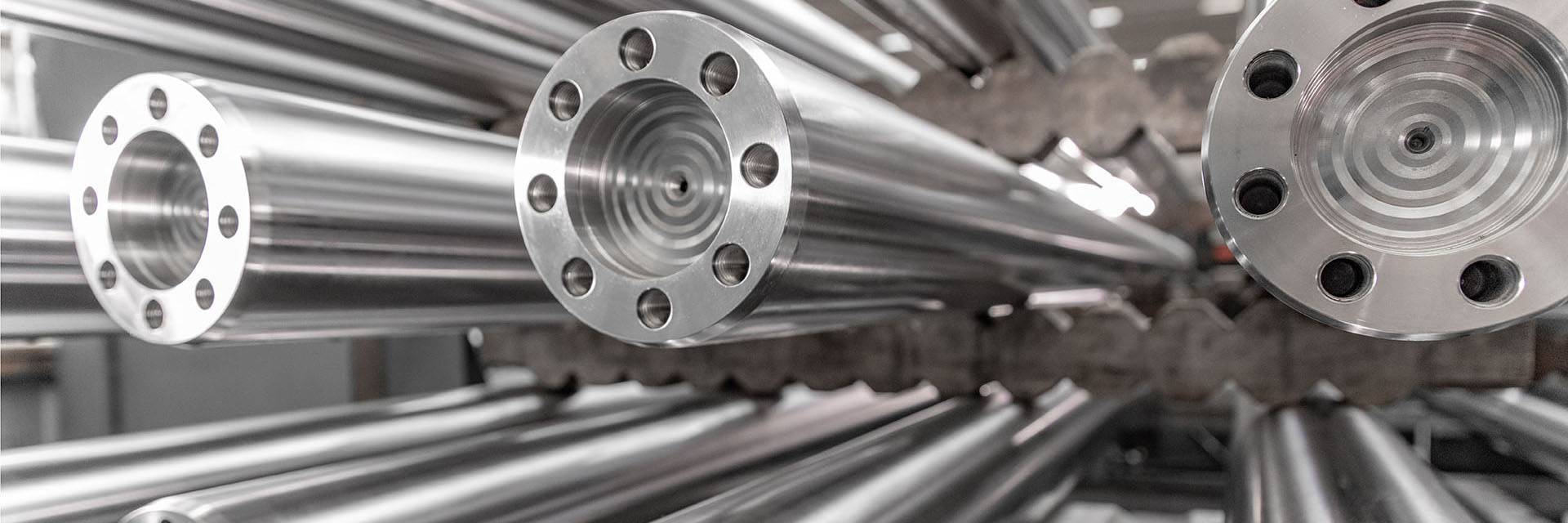
Inductive hardening
By means of CNC-controlled inductive hardening, LinTec increases the wear resistance of the shafts. Hardening depths of 0.5 to 8 millimetres and hardness values of up to 66 HRC can be produced.
Targeted hardening reduces hardening distortion to a minimum. Short heating and austenitising times prevent scale, edge decarburisation and residual austenite. The toughness and strength remain preserved in the unhardened areas. Subsequent machining is always possible.
Alignment
The shafts are straightened after the heat treatment processes and between mechanical
machining steps.
From manual straightening to fully automated straightening with presses and roller straighteners, different straightening methods are used with forces from 10 tonnes to 315 tonnes.


Heat treatment
The heat treatment occurs using annealing plants with an open atmosphere. The temperature range here is between 120°C to 680°C. The control occurs via batch elements. The process is completed by annealing and tempering.
Deep-freezing, tempering
The heat treatment occurs using annealing plants with an open atmosphere. The temperature range here is between 120°C to 680°C. The control occurs via batch elements. The process is completed by annealing and tempering.


Centreless grinding
Centreless grinding is the most economical grinding variants for rod material. The geometry is created here. LinTec grinds in a dimension range from 2 to 205 mm in diameter and a length of up to 7,800 mm. Tolerances IT 6 are standard. IT 5 is possible if necessary.
Polishing
The surface structure is optimised through polishing and belt grinding. At LinTec, systems are used with up to seven polishing stations. The desired surface is achieved in coordinated steps, up to a mean roughness value Ra under 0.15 micrometres. Polishing is also used after the chrome-plating.


Dimensional hard chromium plating
Electroplating has been used at LinTec Aulendorf since 1972. The application and use of chrome-plated component are very complex. It helps with corrosion protection, wear protection and the reduction of frictional resistance. Our customers mainly come from mechanical and plant engineering as well as from the automotive industry.
In our bath electroplating, we are technically capable of chrome-plating shafts and columns up to a length of 8,000 mm, a diameter of 200 mm and a total weight of up to 3,000 kg.
The optimum coating thickness for linear guides is 10 micrometres and for piston rods is between 20 and 30 micrometres. Layer thicknesses of up to 50 µm are possible.
The power required for the coating process is provided and secured via its own transformer station, which is located on the plant premises.
Read on
Using a dual loading and unloading station guarantees efficient work in pendulum operation, therefore allowing for a high material throughput.
The chrome-plating of surfaces with substances containing chromium VI has been significantly reduced since September 2017 due to the REACH regulation. Since this date, hexavalent chromium compounds may only be used by companies who have an approval to use them and ultimately meet all constraints from the official approval document. LinTec Aulendorf meets the REACH regulation to the full extent. In order to be able to comply with the environmentally-relevant statutory provisions in the future as well, massive investments were made in the existing bath electroplating and the systems have been continuously modernised in recent years.
This means we are ideally equipped for coming challenges and customer requests.
Finishing
We produce customer-specific finished parts using different machining methods:
- Turning, conventional
Machinable components: Maximum length 6,300 mm,
Diameter 5 to 380 mm, Maximum weight 2,000 kg - CNC turning
Machinable components: Length 10 mm to 6,280 mm,
Diameter 4 to 400 mm - CNC turning with bar feeder
Machinable components: Maximum length 8,000 mm,
Diameter 3 to 80 mm - CNC milling centre
Traverse paths of X-axis 8,000 mm, Y-axis 630 mm, Z-axis 550 mm,
NC swivel head, speed range 20 rpm to 12,000 rpm,
NC rotary table, dividing accuracy +/- 2“,
Face plate diameter 500 mm







